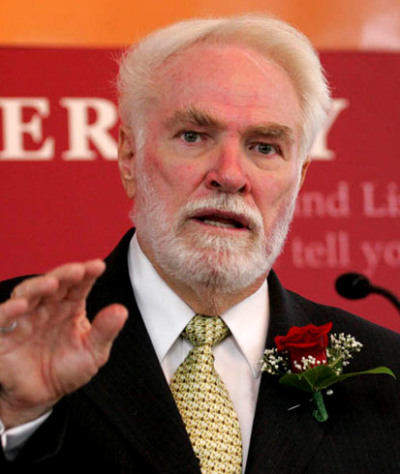How Do Religions Grow? What Evangelicals Can Learn From Comparing Groups (Part 1/8)

Many Christians ofter wonder how the church is doing in carrying out the command of Jesus Christ when he said that we were "to make disciples of all nations." It is true that the church is now the largest religioun in the world and that in many parts of the world there is growth. There is however much concern that the Church seems to be declining in the Middle East and the Western World.
What do we need to do to see the church again grow both in numbers and influence in the West?

One of my mentors while I studied at Fuller Theological Seminary during the 1970's was Dr. Donald McGavran, the world famous founder of the Church Growth Movement. In speaking with me about his philosophy, he often mentioned that the church and its leaders were not being honest with themselves and were claiming growth and success where there was none. Pressures to obtain good results were the cause of many to exaggerate their numbers. The present situation has shown us that the Church Growth Movement has seen its heyday but the reasons for its existence has not changed.
But the question remaining is this: Are some of McGavran's doubts as to the positive reporting of results still a problem in the missionary world of today.
McGavran once wrote: "A strange combination of factors keeps us from perceiving church growth and kept church growth leaders from measuring what has occurred ..."
He went on to say that "many pastors and missionaries surrounded by this opaqueness, carry on programs, preach sermons, do assigned work, raise budgets, administer departments, baptize converts, teach school children and new workers. But only occasionally — when the cloud lifts — do they glimpse briefly into the state of church growth."
Often we believe that everyone knows and understands strategy planning and is ready to attempt great things for God.
As I have studied the growth of the church I have often wondered why some cults, sects, and movements are growing faster than Christianity. Several times I would spend time studying other groups such as the Mormons and the Jehovah's Witnesses and have been impressed by their growth in our modern world, However when I would talk to evangelical leaders about this, I would be told that either we should not be concerned with them because they are only cults, or they really are not growing or, they grow because of the dictatorial structure of their organization and we cannot duplicate it. In other words these leaders simply are not interested in learning what others are doing to grow.
My studies continued and I decided to write a book on the strategies of seven growing groups in the world of religion. One of those groups that I wanted to learn more about was Islam. Since I had been the consultant for Church Growth for the International Mission Board of the Southern Baptists for the Middle East and North Africa, I had the necessary background to write a well founded book on their plans to change the world. I must admit I was very impressed by their plans and the fact that they believe the can take over the whole world by the year 2080.
One of the more interesting facts that I learned in this study was that at least one of their mission strategists, Khervain Mural claimed that Islam works at three levels. He describes them as:
1. The Micro Level: The level of the individual persons and small organizations
2. The Meta Level: The level of very large groups, institutions and structures.
3. The Mega Level: The level of overall Unmah and Muslim socialites and States.
As I continued my studies I wanted to use these levels as a norm in order to see if the other six groups were working on all three levels. To my amazement I discovered that only three of those groups had a Mega strategy in place while the other four were operating almost exclusively on the lower two levels.
One of my great disappointments was that my own denomination, Southern Baptists, were almost void of a constructive strategy at the Mega level. The next question seemed to be important. What would happen if evangelicals began to think on a Mega level instead of only at the Micro and Meta levels.
In the next articles I shall show the reader what I believe would happen if we began to broaden our expectations to not only change the individuals but to also change the complete society for Christ.
In truly understanding how to change society at the Mega level, it would be important to understand the makeup of the society we are trying to change.
Many years ago at an informal meeting, some creative Christian leaders began to discuss this problem and to try to understand the contemporary culture. They arrived at what is known as the seven mountains of culture. They stated that there were seven important parts of any culture: art and theater, business, education, family, government, media, and religion. The argument was that if a strategy was to really penetrate the basic layer of a culture a strategy would need to include reaching all seven parts of a culture.
The leaders have discovered a very important tool in strategy planning for the Christian church. As I studied these seven mountains I became impressed to add three more thus bringing the number to ten. The three I added were the military, sports and technology.
Thus in applying a Mega strategy outlook in our planning it behooves us to also focus in on the larger parts of a culture. A Mega strategy needs to looks at the building blocks of a culture if it seeks to change it and to bring individuals to a saving knowledge of Jesus Christ.
Also see:
How Do Religions Grow? Assemblies of God, Evangelism With Feeling (Part 2/7)
How Do Religions Grow? Jehovah's Witness, a Strict Taskmaster (Part 3/8)
How Do Religions Grow? The Gay Rights Movement's Mega Strategy (Part 4/8)
How Do Religions Grow? Islam's 4 Steps to Change the World (Part 5/8)
How Do Religions Grow? Mormons 'Hidden in Plain Sight' (Part 6/8)
How Do Religions Grow? Southern Baptists, Reversing the Decline (Part 7/8)
How Do Religions Grow? Without a Vision, the People Perish (Part 8/8)



























